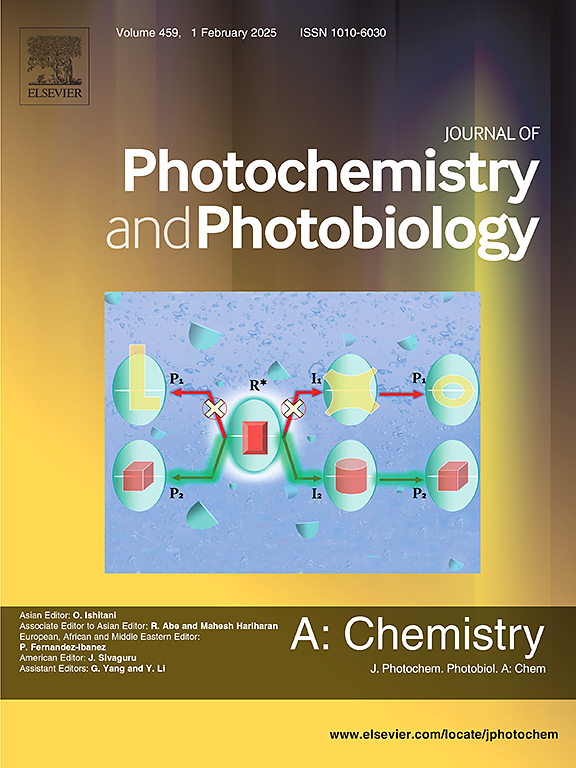1,8-萘酰亚胺/1,2,4-三唑缀合物作为氨和低分子量挥发胺的高灵敏度和自再生固体“肉眼”探针
IF 4.1
3区 化学
Q2 CHEMISTRY, PHYSICAL
Journal of Photochemistry and Photobiology A-chemistry
Pub Date : 2025-06-21
DOI:10.1016/j.jphotochem.2025.116590
引用次数: 0
摘要
开发可靠的低成本荧光探针用于实时检测有毒挥发性有机胺,特别是主要氨,对食品安全和保护公众健康和环境具有重大的社会影响。然而,传统的有机荧光团通常仅在稀溶液中有效,这就是为什么将分子传感器的原理从溶液扩展到固相目前成为当务之急。因此,本文重点研究了两种对C-4氮原子的4-氨基-1,8-萘酰亚胺具有异常高酸度的1,8-萘酰亚胺/1,2,4-三唑缀合物的合成及其在溶液和固体中的光物理性质。由于它们异乎寻常的高酸度,新化合物不仅在溶液中,而且在挥发性胺存在的固态(薄膜和纸条)中,它们的C-4氮很容易去质子化。此外,值得强调的是,在碱性蒸汽存在下形成的非荧光阴离子在中性气氛中迅速中和,而不需要对介质进行额外的酸化。结果表明,所合成的化合物具有很高的潜力,可作为自再生固态比例探针用于挥发性低分子生物胺的比色和荧光检测,可作为快速检测周围环境中有毒气体的有效平台。本文章由计算机程序翻译,如有差异,请以英文原文为准。

Ratiometric 1,8-naphthalimide/1,2,4-triazole conjugates as highly sensitive and self-regenerating solid-state “naked eye” probes for ammonia and low molecular weight volatile amines
The development of reliable low-cost fluorescent probes for real-time detection of toxic volatile organic amines, especially predominant ammonia, entails a significant social effect related to food safety and protection of public health and the environment. However, traditional organic fluorophores are usually effective only in dilute solutions, which is why extending the principles of molecular sensors from solution to solid phase is currently becoming a top priority. That is why, herein we focused on the synthesis and photophysical study in solution and solid-state of two 1,8-naphthalimide/1,2,4-triazole conjugates possessing unusually high for the 4-amino-1,8-naphthalimides acidity of the C-4 nitrogen atom. Due to their unusually high acidity, the new compounds easily deprotonate their C-4 nitrogen not only in solution, but also in the solid state (thin film and strip paper) in the presence of volatile amines. Furthermore, it is worth emphasizing that the formed in the presence of basic vapors non-fluorescent anions are rapidly neutralized in a neutral atmosphere without the need for additional acidification of the medium. The results obtained clearly showed the high potential of the synthesized compounds as self-regenerating solid-state ratiometric probes for colorimetric and fluorescent detection of volatile low molecular biogenic amines and they can be considered as an effective platform for rapid detecting toxic gaseous species in our surrounding environment.
求助全文
通过发布文献求助,成功后即可免费获取论文全文。
去求助
来源期刊
CiteScore
7.90
自引率
7.00%
发文量
580
审稿时长
48 days
期刊介绍:
JPPA publishes the results of fundamental studies on all aspects of chemical phenomena induced by interactions between light and molecules/matter of all kinds.
All systems capable of being described at the molecular or integrated multimolecular level are appropriate for the journal. This includes all molecular chemical species as well as biomolecular, supramolecular, polymer and other macromolecular systems, as well as solid state photochemistry. In addition, the journal publishes studies of semiconductor and other photoactive organic and inorganic materials, photocatalysis (organic, inorganic, supramolecular and superconductor).
The scope includes condensed and gas phase photochemistry, as well as synchrotron radiation chemistry. A broad range of processes and techniques in photochemistry are covered such as light induced energy, electron and proton transfer; nonlinear photochemical behavior; mechanistic investigation of photochemical reactions and identification of the products of photochemical reactions; quantum yield determinations and measurements of rate constants for primary and secondary photochemical processes; steady-state and time-resolved emission, ultrafast spectroscopic methods, single molecule spectroscopy, time resolved X-ray diffraction, luminescence microscopy, and scattering spectroscopy applied to photochemistry. Papers in emerging and applied areas such as luminescent sensors, electroluminescence, solar energy conversion, atmospheric photochemistry, environmental remediation, and related photocatalytic chemistry are also welcome.

 求助内容:
求助内容: 应助结果提醒方式:
应助结果提醒方式:


